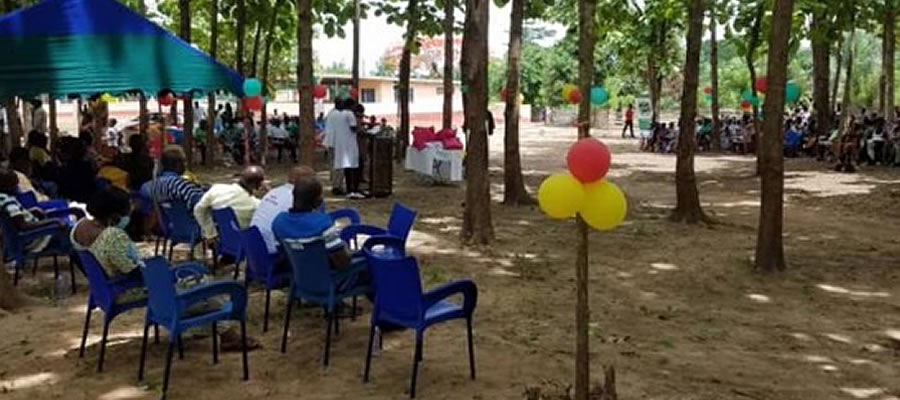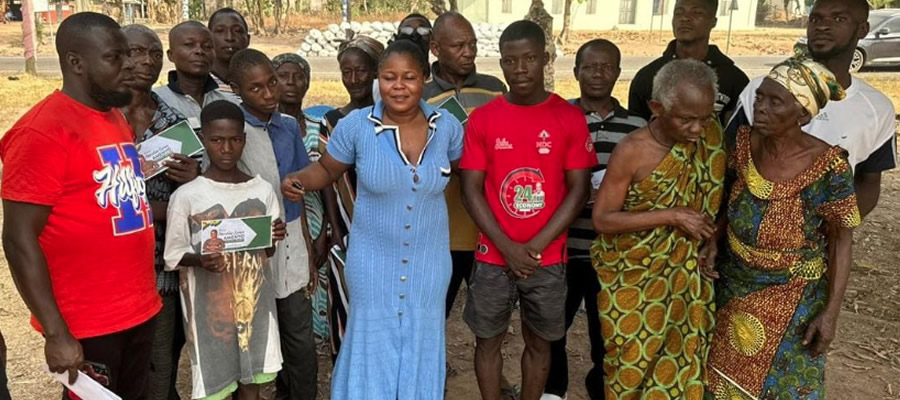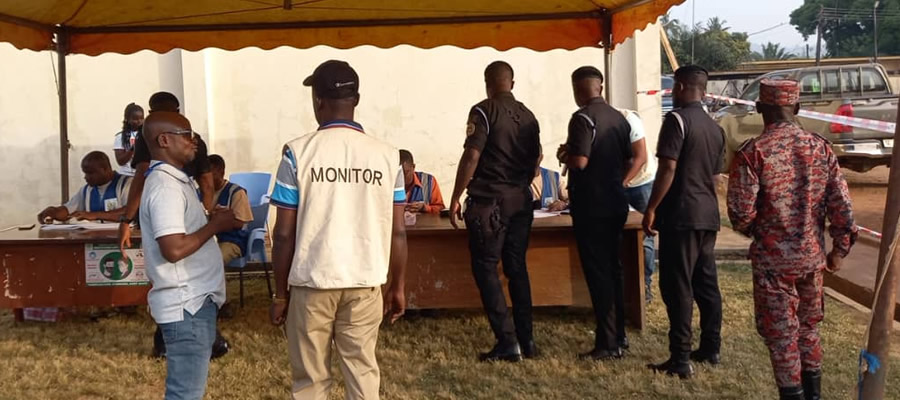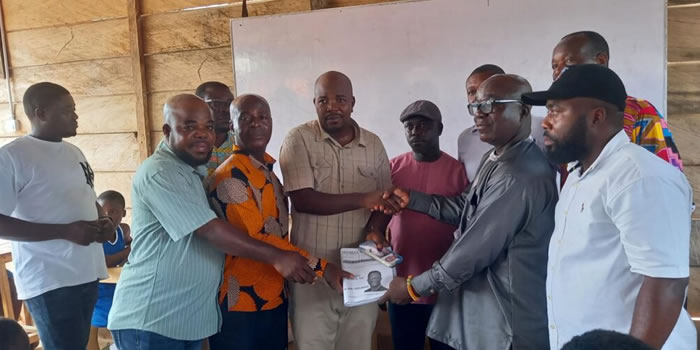

Small Scale Irrigation Project, Hove
The Government of Ghana and the African Development Bank are sponsoring a 85-acre irrigation project at Hove near Koloenu. The objective of the project is to provide irrigation facilities for about 50 farm families to enable them produce vegetables and rice throughout the year. The beneficiaries are to own, manage and maintain the facilities.
The total cost of the project is ¢1.2bn. The beneficiaries community is expected to pay ¢100mcounterpart fund towards the project. The Hohoe Municipal Assembly has paid 050m on behalf of the communities. The Assembly is expected to pay the balance in due course. The contract for constructional work has been awarded and the contractor has moved machinery to the site in the third week of November 2002.
National Livestock Project:
The African Development Bank is funding the National Livestock Project being implemented by the Animal Production Directorate of Ministry of Food and Agriculture. The project aims at assisting livestock farmers in selected Municipal to improve their stock. The activities include procurement and distribution of breeding stocks, assistance for rangeland establishment and trainings for livestock farmers and staff of MOFA.
E-Commerce Project
This is an electronic Commerce Project being piloted in one district in each region. The Ministry of Food and Agriculture in partnership with and support from International Institute for Communication and Development (1ICD) is sponsoring the project, which aims at promoting Non Traditional Export Trade (NTE). The project intends providing NTE producers and traders information about potential markets prices for commodities, and to link them with potential buyers in the national, regional and global markets. The existing methods of linking these people by telephone and fax are not only time consuming but also very expensive.
Under the project, an information center will be equipped with two computers and website established to link MOFA’s network. A database will also be developed to capture data at the district. The Hohoe Municipal Assembly has released part of the Tourist Information Center for this Project, which will also promote the tourism industry in the district. A telephone line has already been approved for the center. Two MOFA staff will be trained to man the center. Potential exporters/importers and the business community will access information at token fees.
Some Large Scale Agricultural farms in the Municipality are as follows | ||||
SECTOR/COMMODITY | COMPANY | LOCATION | ACREAGE | REMARKS |
CROPS |
|
|
|
|
Mango
| Volta Fruits Estate | Ve Wudome | 350 (140ha | Fruiting |
Mango | Volta Integrated Agric Dev | Tafi Abuife | 100 (40 ha) | Not yet fruiting |
Mango | Bomarts Farm | Tafi Abuife | 350 (140ha | Not yet fruiting |
Mango |
Marfco Farms
| Gbi Avega | 100 (40 ha) | Not yet fruiting |
Livestock |
|
|
|
|
Poultry | Hove farms | Ve Hove | 30,000 installed |
|
Irrigation | Small Scale | Ve Hove | 17 (30 | Dry season |
NON - TRADITIONAL SECTOR
Bee - keeping (epi culture) and fish farming are gradually catching up in the district. Pineapples. ginger and soya beans also have great potential. Avocado pears, oranges and mangoes, bananas are grown in the highland areas. Notably among these areas are Logba and Nyagbo. Fodome and Lolobi are noted for oil palm cultivation. Garden eggs are also grown for export.
STRUCTURE
Statistics obtained from the Agricultural Statistics and Census Division, P.P.M.E.D, M.O.F.A, Volta region for 1995 shows the following trends in agriculture in the district: Of the 10026 holders, 14% are below 20 years while 48% fall within the 30-49 age bracket. 33% are between 50 and 64 while 7% are above 64 years. The analysis shows that 60% of the farming population are below 50 years of age, while 40% are above 50 years.
Of the individual size holdings, the statistics show that 9755 holders cultivated less than a hectare. Only 271 cultivated between 1 and 2 hectares. A further look at the sex distribution of holders shows that 62% of the holders are male, while 38% are female. The above analysis show that majority of farmers cultivate small areas of land for their crops. Also about 38% of the holders are women.
AGRICULTURAL EXTENSION DELIVERY
The Ministry of Food and Agriculture through its Agricultural Extension Agents ( AEAs) provide extension services in the following areas. The problems associated with agriculture are:
- Inadequate transport for Extension Staff.
- Low farmer Extension staff ratio.
- Over dependence on rain-fed agriculture.
- Lack of storage facilities.
- Unstable prices for agricultural produce.
- Bad feeder roads, which hinder transportation of foodstuff from growing centers to the market.
- Inadequate credit facilities.
- High cost fertilizers and other agriculture inputs
- Lack of interest of the youth to take up farming from the aged
- Mechanization facilities (Agric Tractor Services)
- Inadequate Agro processing facilities.
NON-RENEWABLE RESOURCES
Minerals:
There are large clay deposits at Akpafu Odomi and in Ve area especially at Koloenu, Dafor and Golokwati. This resource is being used on a small scale for pottery and ceramic works in Ve Area. The potential for large-scale clay-based industries exists, and investors could take advantage of this.
The mining and manufacture of simple farming implements, the hoe. cutlass, sickle etc in akpafu area by the ancestors suggests the existence of large deposits of high grade iron ore especially at Akpafu Todzi. The extent of deposits untapped is yet to be investigated.
Reserves of the iron ore deposits here might call for a large-scale mining industry, the basis for the emergence of an eventual industrial establishment. The Mineral Commission in 1997 granted a concession to an Australian firm for gold prospecting in parts of the district. We are yet to have a report on their activities.
There is also an abandoned Stone Quarry at Alavanyo Wudidi that could be reactivated to boost the construction industry in the district as well as the adjacent district, which also lack such resources. Unsubstantiated reports have it that deposits of mercury, in commercial quantities, exist in the Alavanyo area.
INDUSTRIAL SECTOR
The industrial sector includes:
- Manufacturing
- Construction
- Artisans and Craftsmen
- Technical Infrastructure.
The industrial sector has seen a modest increase of about 1.5% over the past five years.
No | INDUSTRY | TYPE | PRODUCT | LOCATION |
1. | Brick and Tile | Small Scale | Burnt Bricks, Rooting Tiles | Ve Koloenu. Ve Dator |
2. | Pottery and Ceramics | Small Scale | Coolers, Glazed Cups & Plates | Ve Koloenu |
3. | Gold Smithery | Small Scale | Jewelry -Ear- rings. Rings. Necklace | Ho hoe |
4 | Black Smithery | Small Scale | Hoes, Earth Chisel, Traps. Go-to-Hell, Sickel, Knives | Alavanyo, Lolobi. Hohoe, Likpe Abrani. Agate |
5 | Distillery | Small Scale | Akpeteshie (local gin) | Hohoe, Fodome. Ve, |
6 | Bagged Water | Medium Scale | Pure Water" in Sachet | Logba Tola, Hohoe |
7 | Key Cutting | Small Scale | All types of keys | Hohoe |
8 | Carving | Small Scale | Profiles, Effigies etc | Have, Alavanyo |
9 | Packaging | Small Scale | Mango Fruits | Ve WudoiTie |
10 | Weaving | Small Scale | Kente Cloth, Knapkins, Kente Stoles | Tafi Abuife, Hohoe, |
11 | Traditional Medicine | Small Scale | Assorted Herbal preparations including: Vision Corrector (Dr.Noamesi),Ahodeng Herbal Brew,Alafia Bitters (Mr. Domi | Hohoe |
12 | Batik .Tie and Dye | Small Scale | Materials for clothing | Hohoe |
13 | Oil Extraction | Small Scale | Edible Palm Oil, | Logba, Lolobi. Gbledi. |
14 | Soap Making | Small Scale | Local Laundry Soap | Lolobi. Likpe, Akpafu |
15 | Bakery | Small Scale | Break, Biscuits, Confectionery | Hohoe. Agate |
16 | Milling | Small Scale | Maize Flour, Cassava Flour, Corn Dough, Poultry Feed | District-wide. Poultry |
17 | Cassava Processing | Small Scale | Cassava Dough, Gari | District-wide |
18 | Rice Mills (Haulers | Small Scale | Polished Rice | Hohoe, Lolobi |
19 | Coffee Haulers | Small Scale | Coffee Nuts | Hohoe |
Production Technology:
Simple tools are still used in most cases. Much more needs to be done by introduction of simplemodern machines to improve the capacity and capabilities of those in the manufacturing sector.
Service Industry
The service industry employs 21% of the EAP (ie about 11,378 workers) five years ago. The breakdown as compared with the present situation is as shown in table X below.
SUB-SECTOR | 1996 (%) | 2001 |
1. Public Services | 5.1 | 4.0 |
2. Commerce (Trading | 14.2 | 15.3 |
3. Transportation | 1.2 | 2.2 |
population per branch (38,000:1) a low level of bank transactions, the district is just fairly better off than the surrounding ones.
There are four major Commercial Banks and two Rural Banks operating in Hohoe the District Capital.
These are : Ghana Commercial Bank, Barclays Bank Ghana Ltd, Agricultural Development Bank, and
First Ghana Building Society. Weto Rural Bank located at Kpeve and Asubonten Rural Bank based at
Worawora have established branches at Hohoe. There is also a branch of Bank of Ghana established at
Hohoe. an additional advantage for banking and financial transactions in Hohoe Municipality.
Another financial institution operating in the district is the State Insurance Corporation located in.
Hohoe. A few Susu Operators exist in the Capital, serving as a non-formal banking system in, a situation that can serve as a basis for mobilization of funds into savings by the formal.
Banking system
Extensive awareness creation about the utilization of the banking system can lead to an effective.
mobilization of funds into savings from the increasing/rising numbers of small scale businesses in the district.
Hohoe Town has a history of having served as the commercial center of the Volta Region.
Between the period 1960-1995, however, certain factors contributed to the loss of its capacity to sustain tlie
commercial function. Factors contributing to this state of affairs include:
Lack of political will that ensures that development issues are kept in the mainstream
Date Created : 11/21/2017 1:46:49 AM












 facebook
facebook
 twitter
twitter
 Youtube
Youtube
 +233 593 831 280
+233 593 831 280 0800 430 430
0800 430 430 GPS: GE-231-4383
GPS: GE-231-4383 info@ghanadistricts.com
info@ghanadistricts.com Box GP1044, Accra, Ghana
Box GP1044, Accra, Ghana